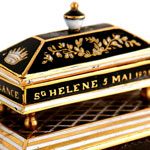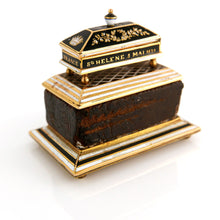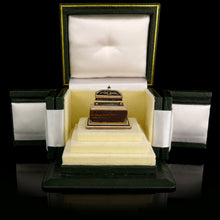Emperor Napoleon I - An Important Relic of the ‘Retour des Cendres’, 1840
Adding product to your cart
Mahogany, gold and enamel. A relic of the exhumation and return of Napoleon I’s mortal remains from St. Helena to France in 1840, comprising a piece of mahogany from the outer coffin in which the Emperor was interred in 1821, applied with a miniature coffin in gold set with enamels, and inscribed with the date of the emperor’s death - ‘Sainte-Hélène 5 mai 1821’ (St. Helena 5 May 1821), - and, last words, ‘Mon fils, tête de l’Armée, France’ - (My son, head of the army, France); the coffin lid, hinged at the head end, opening to reveal a miniature recumbent figure of Napoleon in gold; the interior of the casket lid containing strands of Napoleon’s hair in a glazed compartment. The whole set upon a rectangular base plate in gold set on four ball feet, the underside engraved ‘Bois du Cercueil de / NAPOLEON / rapporté par le Cte Phpe / de Chabot le / Octobre 18, 1840’ (Wood of the Coffin of Napoleon brought back by Count Philippe de Rohan-Chabot).
Provenance:
Philippe de Rohan-Chabot, Viscomte Chabot (1815-1875),
King’s Commissioner in the recovery of Napoleon’s remains, 1840,
French Ambassador to the United Kingdom, 1871-1875.
Read more
The ‘retour des cendres’ (return of the ashes) was the homecoming of the mortal remains of Napoleon I from the island of St. Helena and to the Hôtel des Invalides in Paris in 1840. It was the defining moment in the long-awaited rehabilitation of France’s Revolutionary and Imperial periods, as well as the fulfilment of Napoleon’s dying wish to buried on the banks of the Seine among the French people. The mission of 1840 was instigated by the embattled prime minister of the day, Adolphe Thiers, who, as a historian of the Consulate and First Empire, saw the return as a grand political gesture - a coup de théâtre - that would both flatter the radical left and bolster the unpopular monarchy of King Louis-Philippe. Recalling royalist fears of political unrest that had prevented the return of Napoleon’s remains in 1822 and 1830, the King was hesitant but was ultimately persuaded to give Thiers his support. His change of heart accorded with the royal policy to regain ‘all the glories of France’, to which he had dedicated the Château de Versailles as a museum.
Thiers launched his campaign with a private request to the British minister Lord Clarendon, telling him ‘To keep a cadaver as a prisoner is not worthy of you, nor is it possible on the part of a government such as yours. The restitution of these remains is the final act of putting behind us the fifty years that have passed, and will be the seal placed on our reconciliation, and our close alliance.’ The French ambassador in London, submitted the official request to the British which was approved by ministers according to a promise made in 1822. Nontheless Prime Minister Palmerston sought the view of Napoleon’s vanquisher the Duke of Wellington. As a public figure the Iron Duke declared he had no opinion, but as private individual he retorted he ‘did not care one twopenny damn what becomes of the ashes of Napoleon Bonaparte.’
The King’s third son, François Frédéric d'Orléans, Prince de Joinville, who was a captain in the French Navy, was appointed to the command the expedition. Louis-Philippe, however, feared a diplomatic disaster and accordingly appointed Philippe Chabot, then a twenty-five year old attaché at the London embassy with part British ancestry to serve as the King’s Commissioner and to take a fall if necessary. Chabot’s responsibilities included superintending exhumation operations, and accepting in the King’s name the surrender of the body of the Emperor of France.
The mission sailed on 7 July 1840 in two ships, the frigate Belle Poulle and the corvette Favorite, and in defiance of its sombre purpose, headed south in an atmosphere of youthful high spirits. Only the first rumblings of an international incident known as the Oriental Crisis of 1840, threatened to spoil the party. The voyage lasted 93 days with Chabot, Prince Joinville and his officers making runs ashore at Cadiz, Madeira, Tenerife, and partying for fifteen days at Bahia, Brazil, before heading out into the South Atlantic for St. Helena. The two ships finally reached the island on 8 October and in the roadstead found the French brig Oreste which carried further news of the rift between Britain and France. Chabot and the prince felt that their mission on the island would be respected but began to fear that they might be intercepted by the Royal Navy on the return voyage.
On the night of 14 October Chabot led the French delegation to the Valley of the Tomb, where by the light of torches, British soldiers laboured until dawn disinterring the Emperor from the iron and stone bound tomb devised by his former gaoler, Sir Hudson Lowe. The French party included General Marchand, who had fought in Napoleon’s celebrated Italian Campaign of 1796-97; General Bertrand, a veteran of Egypt, Austerlitz and Waterloo; and General Gourgaud, who had been the first man into the Kremlin in 1812 and later saved Napoleon’s life by killing the leader of a band of Cossacks at the Battle of Brienne in 1814. Count Emmanuel de Las Cases, the son of Napoleon’s unofficial secretary on St Helena; three of the Emperor’s former servants’ a naval chaplain, the Abbé Coquereau, and two choir boys; a couple of former attendants; three naval officers, Captains Guyet of the Belle Poule, Charner of the Favorite, and Doret of the Oreste; Dr. Guillard, the chief surgeon of the Belle Poule, and an unnamed lead-worker completed the party. Prince de Joinville, however remained on board ship since he felt he could not be present at work that he could not direct.
Shortly after 9.30 am on the 15th, Chabot oversaw the transfer of the Emperor to a nearby tent where the multiple coffns in which he lay were opened. The multiple coffins were well documented in accounts of the original burial in 1821. Dr. Antommarchi’s account published in 1825 correctly stated: ‘The body was placed in the tin case’, but inaccurately added it was, ‘placed in another coffin of mahogany,’ before accurately continuing ‘which we placed in a third made of lead, which was itself placed in a fourth made of mahogany.’Antomarchi’s mistake in describing the second coffin as being of mahogany was highlighted by the St. Helena undertaker in 1821, Andrew Darling (1781-1841) who noted, mahogany was a rare wood on Saint Helena, and that he had had to find and dismember a dining table in order to build the fourth casket. It is this wood from the dining table that for some nineteen years encased the Emperor, that comprises the essential element of the present relic.
Two holes were pierced through to allow any gases to escape. The ends were then sawn off the outer mahogany coffin to facilitate the extraction of the lead coffin within it. The lead coffin was opened, the wooden coffin unnailed, and finally the tin casket unsealed. The Belle Poule’s surgeon lifted the white satin lining which had become detached from the lid of the tin coffin. Napoleon's chasseur uniform was perfectly preserved although his decorations and buttons were slightly tarnished. The body was in a comfortable position, the head resting on a cushion and the left forearm and hand on the thigh - the facial expression, apparently, serene. The eyes were fully closed. The hands were perfectly preserved, with long and very white. Only the seams of the boots had cracked, showing the four smaller toes on each foot.
Chabot, Las Cases, and the Generals were reportedly ‘overcome with emotion’. The surgeon, Guillard proposed that he continue examining the body and open the jars containing the heart and the stomach. Baron Gourgaud became angry and ordered that the coffin be closed at once. The doctor complied, putting back on the tin lid. The wooden coffin was nailed shut and the leadworker sealed the lead coffin. The whole was placed in a massive Roman-style ebony coffin with a complex locking system that had been brought from France. As the present relic demonstrates, it was the fourth coffin (in mahogany) that was cut up and the pieces distributed to Chabot and other members of the mission. General Gourgaud received a large piece that survives today in the Musée Napoléonien de l’île d’Aix. The ebony coffin and its contents were then placed in a sixth coffin, made of oak and designed to protect that of ebony. Then this mass, totalling 1,200 kilos, was hoisted by 43 gunners onto a solid hearse, draped in black with four plumes of black feathers at each corner and drawn with great difficulty by four horses caparisoned in black to the Belle Poule.
At 3.30, in driving rain, with the citadel and Belle Poule firing alternate gun salutes, the cortège slowly moved along under the command of the island’s governor George Middlemore - an old Penisula veteran who hated the whole affair and generally had as little to do with it as possible. Count Bertrand, Baron Gourgaud, Las Cases and Marchand walked holding the corners of the pall. A detachment of militia brought up the rear, followed by a crowd of people, while the forts fired their cannon on every minute. Reaching Jamestown, the procession marched between two ranks of garrison soldiers with arms reversed. The French ships lowered their launches, with that of Belle Poule, ornamented with gilded eagles, carrying Joinville.
At 5.30 the funeral procession stopped at the end of the jetty and the remains were officially handed over to Chabot and thereby France. The heavy coffin was placed in the launch. The French ships hoisted their colours and all the ships fired their guns, drums beat a salute and funeral airs were played. The coffin was hoisted onto the deck and its oak envelope was taken off. Coquereau gave absolution. Napoleon had returned to French territory. At 6.30 the coffin was placed in a candlelit chapel, ornamented with military trophies, on the stern of the ship. At 10am the following day mass was said on deck, and the coffin lowered below.
On 18 October Belle Poule and Favorite sailed for France at full speed. Two merchant ships confirmed war was imminent, causing Joinville to prepare for battle. Temporary cabins set up to house Chabot and the rest were demolished and the furniture thrown overboard, in order to mount the full complement of guns. The crew were drilled regularly and frequently called to action stations, and the slower Favorite was ordered to the nearest French port. By 27 November, however, as Belle Poule neared Cherbourg, these precautions proved unnecessary. The Anglo-French tension had eased, after France had abandoned its Egyptian ally and Prime Minister Thiers had been forced to resign.
The return of the remains to boost the image of the July Monarchy and to provide a tinge of glory to its organisers, Thiers and Louis-Philippe, had seemingly failed. Yet it had initiated something far greater, a focal point of the Napoleonic legend. On 30 November, the ship reached Cherbourg, where Emperor was transferred to La Normandie, which took it to Val-de-la-Haye, near Rouen. Here he was transferred to the steamer La Dorade, to be carried up the Seine. On 14 December, La Dorade moored at Courbevoie, a village just northwest of Paris. Political sensitivities of the weakened monarchy and a shaky new administration resulted in a scaling back of the reburial. The great majority of the French, excited by the return of the remains of one whom they had come to see as a martyr, felt betrayed and angry that they had been unable to pay homage as they had wished.
On December 15, 1840, Napoleon’s body was transferred to an enormous funeral carriage drawn by sixteen black horses. It proceeded across the Neuilly bridge to the Arc de Triomphe, and from there along the Champs-Élysées and across the Pont de la Concorde to a funeral service at the Invalides. Napoleon’s body remained in the Chapel of Saint-Jérôme at the Invalides for over 20 years, and it was not until 2 April 1861 that the real triumph of Philippe de Rohan-Chabot’s mission was fuflilled when Napoleon’s body (within its multiple coffins) was finally place inside the world famous sarcophagus of red quartzite beneath the dome of the Invalides in a private ceremony attended by Emperor Napoleon III (Napoleon’s nephew), his immediate family, government ministers and senior officials.
Philippe-Ferdinand-Auguste de Rohan-Chabot (1815-1875) was the son of a Breton aristocrat the Count of Jarnac and his wife Lady Isabella FitzGerald, daughter of the 2nd Duke of Leinster. His father was a refugee from Revolutionary France. After his arrival in Ireland in 1790, he fought in the British Army against Napoleon. His mother was afterwards lady-in-waiting to Queen Maria Amalia of France.
Known as the Viscomte de Chabot, Phillipe was educated at Harrow and entered the French diplomatic service. Posted as embassy attaché in London, he was appointed in 1840, at the age of twenty-five, King’s Commissioner on the expedition to recover the remains of Napoleon I. As a matter of record it fell to him to measure and record every detail of the Emperor’s exhumation, and thereby lay to rest rumours which nevertheless persisted until the late 20th century that Napoleon’s tomb was empty.
As chargé d’affaires in 1843 he accompanied Prince de Joinville on a vist to Queen Victoria and Prince Albert at Windsor Castle. Appointed Minister Plenipotentiary in London in 1846, he negotiated with the settlement a dispute arising from the French seizure of islands in Polynesia and the expulsion of the British consul from Tahiti, with the then Foreign Secretary, Lord Palmertson. He married in 1844 Geraldine, his first cousin, daughter of the 3rd Baron Foley. Appointed French Ambassador to the United Kingdom in 1871, he died unexpectedly on March 22, 1875 at the French Embassy at Albert Gate, Hyde Park. His honours included Grand Officer of the Legion d’Honneur; Honorary Knight Grand Cross of the Bath and Knight of the Sovereign Order of Malta.








